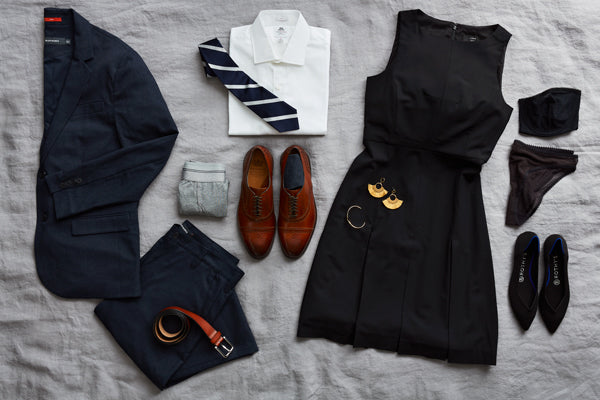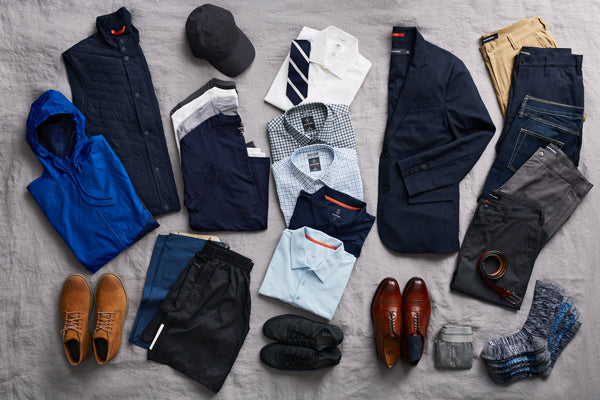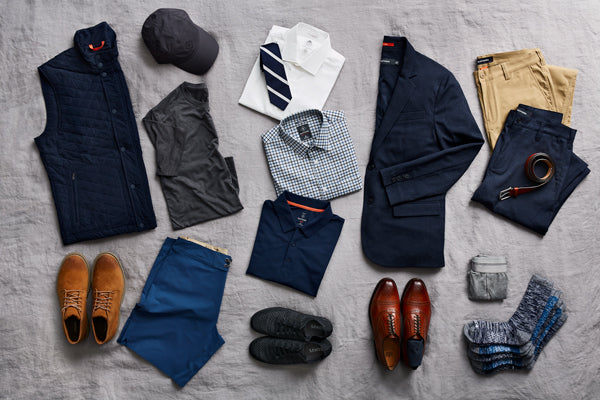Helping people figure out what to pack can be tricky.
This guidance is for the person who finds packing to be something of a wrestling match and is always unhappy with what they bring.
Our approach begins by acknowledging that everyone’s trip is different. So, aggressively prescribing the “ultimate packing list” for 10 days in Paris, without helping you address your specific needs won’t solve your problem. It will only pile on the pressure.
Instead, we present our system, which:
- Includes everything we need
- Helps us leave out what we don’t
- Proves we will have enough
So without further delay…
Step 1: Identify Key Items

Our strategy begins with selecting the most important items for your trip – these critical items are related to where you’re going, and what you’re going to do. They’re pieces or outfits that you truly can’t do without for a specific event or activity.
- "A blazer for my meeting"
- "My favorite dress for going out"
- “Clothes and gear for our hike", etc.
Some people do this by making a list on paper. Others begin grabbing things and placing them on the bed.
Either way, at this stage your job is to identify only top priority pieces and resist getting sucked into stressing about anything else you might need. Those considerations come in a later step.
Approach
- Get all of the things to make up your key outfits, and lay them on your bed / floor / table. (Or write them down on your list, but we find the physical, visual process most helpful.)
- Be sure to include every single item you need for the entire outfit. For example, include the shoes to go with your suit, tie or pocket square, necklace for your dress, walking shoes, etc.
- Ignore minor supporting items like socks and underwear. Unless they are unique and required for your trip – the underwear that doesn’t show lines, socks to go with your dress shoes, hiking socks, etc – then, do include them.
If you’re already thinking about things you can re-wear (like wearing the same blazer with chinos for the rehearsal dinner and with suit pants for the wedding), then you’re ahead of the game.
By doing this step first, you’ll become confident that you’ll have what you need for the most important events of your trip – and you’ll start feeling more comfortable with the overall packing process.
Result: A collection of complete key outfits organized on the bed.
Step 2: Fill in Your Trip Packing List

The next step is to fill in what you’d like to bring for the rest of the trip.
This is usually done by thinking about what you want to wear each day, the places you will likely visit, the weather, etc. Feel free to throw in everything that you think you may want to bring, as this is the phase where it’s OK to overpack.
Someday, you may instinctively pack fewer things. But for now, this is not the time to struggle. Include everything you want. We will trim it down later.
Approach
- Go one day at a time, outlining what you plan to wear and adding each item.
- Add all the supporting pieces, like socks, underwear, scarves, shoes, etc.
- No limits. Include that extra sweater or jacket.
- Place all of the items on the bed (or add to the list), but keep them separate from your critical outfits.
The pile is already probably looking like too much. Don’t worry, we’ll fix that later.
Result: A pile of stuff you are considering bringing, next to your well-planned outfits.
Step 3: Plan for Laundry
Many of us especially despise doing laundry on a trip because we don’t want to take time out of our precious vacation, and the potential for exorbitant hotel charges (and fear of loss or damage) makes the whole experience seem unappealing.
The thing is, it doesn’t have to be so bad. If you were going to Paris for 10 days, and I was able to convince you to do laundry once, we could immediately cut your packing list in half, in one fell swoop.
Planning for laundry may be the easiest thing you can do to pack lighter, and once you embrace it, it will feel like an ally, not an enemy.
Our basic take on laundry is:
-
Recognize that it’s available – Getting your laundry done while traveling is often easier than you’d imagine. I once had a debate with my father-in-law about whether laundry was available downtown in a large Russian city. Of course, it was – you just have to look for it. Whether it’s a laundromat or a delivery service on your app, other people do laundry wherever you are. Sometimes the developing world is the easiest place to get it done.
-
You can plan it in advance – Laundry need not remain a mystery to be solved once you're on the ground. Particularly with today’s resources, the chances are high you may be able to know exactly where you will do your laundry before you depart. And if not, asking around when you arrive will likely yield a solution, and maybe a new acquaintance.
-
The cost is worth it – If you’re anything like me, you may have hang-ups about spending $$$ on certain things. And laundry used to be one of them. But it usually doesn’t cost that much, and when I let it go of my resistance, the benefit was huge. In reality, the money spent was a tiny fraction of my overall trip budget and made me so much more comfortable the entire way. Not to mention, it almost always cheaper than checking another bag.
-
A break may help you – We imagine that we’ll resent the time laundry takes because time is typically in such short supply while traveling. But the reality is that you’ll probably benefit from some downtime anyway. It’s hard to go nonstop every moment of a trip, and I find laundry to be a great time to recharge or plan my next move.
For more details and a comparison of the options available, see our approach to doing laundry while traveling.
Approach
- Rest assured that wherever you go, the people you meet do laundry too, and will be able to help you. Don’t be afraid to ask for advice from any local contacts you might have, and see what information is available online about specific options.
- Figure out when you’ll do laundry, either down to the exact day and time, or a general range of “Tuesday or Wednesday”, if the information isn’t clear before you go. Depending on the method you’re using, you may need to account for dropoff and pickup timing, when to start and change the load, and if you’ll need to wait at a laundromat or not. (At this point, you may want to add this into your schedule or itinerary.)
- Rearrange your clothes with the laundry plan in mind, setting aside what’s no longer necessary.
- Don’t forget, you can’t wash all of your clothes at once. You need something to wear while you wait. Keep this in mind for your packing and outfit planning.
Result: A plan for laundry approach and how many days do you need to pack for.
Step 4: Reduce and Finalize Your Packing List

Now that you have a laundry plan, it’s time to make some final decisions on what to bring and lighten your load.
Approach:
- Your key outfit (for the one formal event) should already be complete, organized, and laid out on the bed.
- Everything else you want to bring should be in its own area, also on the bed.
- Begin creating a mental map of what you will wear each day, up until when laundry is done. (You can also write this down.)
- Prioritize pieces that can be worn multiple times, and mix and match well together. For cold weather, look to layer multiple items, rather than bring something huge.
- Remove items that aren’t necessary, complementary to other garments, washable, etc.
What makes one garment better than another? First, technical performance qualities like wrinkle and odor resistance mean that you can rewear something without having to do anything. Second, lightweight or smaller items are easier to pack. Lastly, fabrics that are machine-washable will be easier to care for (and contribute to your laundry approach rather than work against it).
Result: What you need to pack for your trip, trimmed down to the necessities and factoring in laundry and reuse.
An Example: How to Pack for 10 Days in Paris, 3 Ways
Let’s look at how a guy could pack for the following trip:
- 10 days in Paris
- One formal event, like a wedding (remember Step #1)
- Do laundry once = packing for 5-6 days worth of outfits
If there are five days before doing laundry, consider these three different packing list scenarios:
- Bring everything we think we need, without worrying about capacity or weight. (But remember, we’re still doing laundry once in this scenario.)
- Apply a little reuse, factoring in wearing things more than once.
- A truly lightweight packing approach, where your travel clothes really earn their keep.











